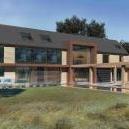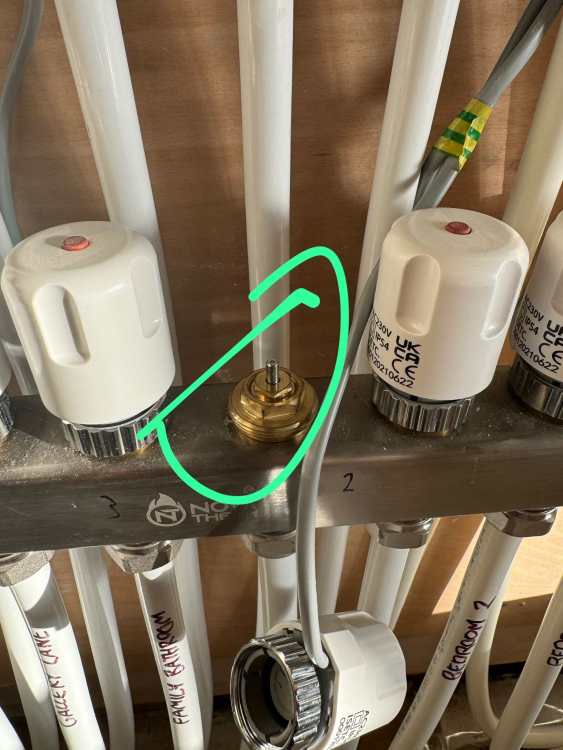-
Posts
183 -
Joined
-
Last visited
-
Days Won
1
thefoxesmaltings last won the day on September 27 2024
thefoxesmaltings had the most liked content!
Personal Information
-
About Me
https://instagram.com/thefoxesmaltings
Recent Profile Visitors
The recent visitors block is disabled and is not being shown to other users.
thefoxesmaltings's Achievements

Regular Member (4/5)
55
Reputation
-
We've got 8 zones, split across 4 UFH manifolds and pumps. How would I go about balancing the flow rates either side of the buffer? No, not running for short periods, it's on 24/7, minus a 3 hour window where the electricity rate is higher, so we don't call for heating demand during 4-7pm, but that's it. Weather compensation curve is set to max 35c at -5c external temp. I could try increasing the external temp to say -3/-2?
-
I'm not sure if those are return temps. It's the only thermometer on the UFH manifolds. Apologies, I am still learning! Yes, we are getting DHW fine from the system reliably. No issue with that. There are two separate tanks within the hot water tank. One for UFH and one for DHW. The DHW is around 45c and set to come on a schedule.
-
Trying to do a bit of investigation as to why the house is feeling a bit cold. Currently at 19c, when thermostats are set to 21c. The leaving water temp according to my ASHP Daikin controller next to the water tank is 31c, yet on the UFH manifold, it's reading 25c on the manual thermometer (and upstairs as low as 20c). - Is this normal, and expected?
-
No problem. In the early design drawing stage, no not really, but there are a few things you need to think about a little further on, which I wish someone told me! What is your finished floor covering going to be? Microcement/polished concrete = easy. Engineered wood (like us), will need a little more thought when it comes to fitting and for expansion allowance. Your plasterer will need to be onboard with the idea, as it'll be his skimming which determines how clean the finish is. How do you plan to finish around your doors? Do you also want a shadow gap, or an architrave?
-

Clicking noise from UFH manifold when it fires up
thefoxesmaltings replied to thefoxesmaltings's topic in Underfloor Heating
Done that. Should the actuator pin move loosely and freely if there is no heating demand at the moment? It does move, up and down if I press it, but takes a fair bit of pressing, and almost if like there is pressure behind it. -

Clicking noise from UFH manifold when it fires up
thefoxesmaltings replied to thefoxesmaltings's topic in Underfloor Heating
So I've narrowed the noise coming specifically from one of the actuators. But the actuator seems to still be opening and closing correctly, so doesn't suggest a stuck pin? It's a bit bothersome to be honest - quite loud! -
Got this clicking sound from one of the underfloor heating manifolds. It doesn't sound like it's coming from the pump, but the manifold itself. To be honest it's quite hard to pinpoint where it's coming from exactly. It starts when the manifold first fires up each time, with the clicking happening very frequently, but over the course of a couple of minutes gradually slows down, and finally stops. Any ideas? WhatsApp Video 2024-10-22 at 09.49.57_2909c610.mp4
-
You are right. It doesn't need to be the same temperature as the house, and is a unheated space. It's still got the same 220mm insulation in the walls though (minus the garage door itself), so even if cold outside, it does tend to stay fairly warm. It hasn't dropped below 17c this year since the start of Autumn, but I expect will, once we get into the deep of winter. Potentially - it's a fire door which the garage/gym can directly be accessed from the house. Maybe it's as simple as a rubber gasket being places all around? Something to explore... Sadly we weren't told by anyone, or those above trades. C'est la vie. Arguably, it's my fault as project manager for not knowing better or doing my research on that. I suppose we lucked out in that sense of achieving a 2.2 rating, having not done a prior test.
-
No negativity taken at all. To be honest what mostly let's us down is the gym/garage door - It is insulated, and has a "seal" at the bottom, but is by no means a 'passivhaus' rated or designed door. Partly due to the fact that we couldn't find any roller doors which met this standard. And we couldn't have a sectional door overhead, as the MVHR ductwork was in the way. There was also no loft hatch in place at the time of the air test. Albeit the internal loft is sealed, the air tester said it would make a difference, but I don't know if that is true. Being first-timers, we didn't know that typically you can do an air test before everything is boarded/sealed up, to find and remediate leaks, and then do the final one at the end to get the as-is value. Lessons learned for next time, I suppose.
-
Yes, Turners also provided us with an insulated roof - 150mm, in both the pitched and flat roof sections. They also provided us with the loft roll insulation (which we installed ourselves) in the raised tie truss areas. Double glazing U values vary, as the thickness of the frame contributes slightly - around 1.1 W/m²k.
-
The TF company (Turner Timber) had an additional insulation package, which they affixed onsite. probably not shown on the program - 100mm to the internal face of the walls. 120mm which was already in the frame. Yeah triple glazing was out of the question for us, mostly due to budget and the sheer size of some of our panes. The largest being 4.5m x 3.1m high. These weighed 750kg alone, so to have gone down the triple glazing route, would have meant additional structural engineering costs and probably beefing up the steel.
-
Thanks - glad you enjoyed it. Yes wet underfloor heating throughout. The first-floor build up is Open posi joists, 22mm egger protect chipboard, 15mm insulated UFH board to which the underfloor heating pipes were laid in. These insulated UFH boards were contact adhesive, and mechanically fixed down to the primed chipboard. Then we installed 14mm engineered wood onto this, which had to be glued down.
-
One thing that might help, and I forgot to add into the original post is a breakdown of the house technicals. Off the top of my head... Block & Beam subfloor. Timber frame to 0.09 wall U-value. (220mm insulation to walls. 150mm to roof). Double glazing, with solar glass spec to large south facing units. Brick clad and slate roof. MVHR + Comfoclime Cooling and heating. Air Source Heat Pump 10kW PV System, 10kW Battery Store & EV Charger. UFH Upstairs & downstairs. Energy rating of A. Air Tightness of 2.22.






